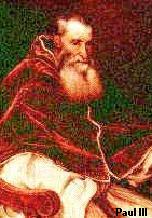 Paul III, like the fabled Janus, looks two ways, back to the bad old times
of Renaissance Rome, forward to the glory of the Catholic Reform.
Paul III, like the fabled Janus, looks two ways, back to the bad old times
of Renaissance Rome, forward to the glory of the Catholic Reform.
Alessandro Farnese was born of a noble family in 1468. Educated by Pomponio
Leto in the house of Lorenzo de' Medici and at the University of Pavia, he
was steeped in Renaissance culture and Renaissance morality. Though he
entered the service of the Church and was created cardinal in 1503 by
Alexander VI, he lived a loose life. But he gradually improved, and when in
1519 he decided to become a priest, he turned over a new leaf and
thenceforth lived chastely. Agreeable and competent, he got along with the
variety of popes he served from Alexander VI to Clement VII. And when
Clement died, Alessandro's election was achieved with ease and hailed with
delight.
Paul III, as he chose to be called, was a good pope, a strong pope,
sagacious, energetic, and largely devoted; not entirely devoted, for he was
guilty of favoring his relations. But he compensated for this dangerous
fault by his great work in promoting the Catholic Reform.
Paul III began to do what Adrian VI had been prevented by death from doing.
Paul did not merely talk reform, he reformed. There was a crying need for
spiritual cardinals to replace the worldly Renaissance princes of the last
generation. Paul filled the sacred college with earnest reformers, men like
Gian Pietro Caraffa and Reginald Pole.
There was a crying need for reform in the papal curia. Paul began that work
over the agonized protests of vested interest. There was a crying need for
reform of the clergy and the religious orders. Paul gave strong support to
new orders and reforms of the old orders. He backed up reforming bishops
who put their dioceses in order. On September 27, 1540, Paul approved of
the Society of Jesus, and before his pontificate was over, Ignatius and his
followers were spreading throughout Europe and Xavier had left for India
and spiritual conquest. Paul favored the Theatines, the Barnabites, and the
Ursulines, and in a time of trial, his wisdom protected the great reform
order of the Capuchins.
Above all, Paul after most vexing difficulties got the long-desired general
council under way. On December 13, 1547, his legates opened the Council of
Trent. And Trent is a watershed in church history.
Paul III forbade the enslavement of the Indians. He rebuked Francis I for
his ferocious cruelty toward the Protestants, while, on the other hand, he
established the Index of Forbidden Books to check heretical tendencies. He
was a great patron of art. Under him Michael Angelo began that dome of St.
Peter's which today is a landmark of Rome.
But Paul's great glory lies in the fact that when he died on November
10, 1549, a new era had been born, the era of the Catholic Reform.
Excerpted from "Popes
Through the Ages" by Joseph Brusher, S.J.

